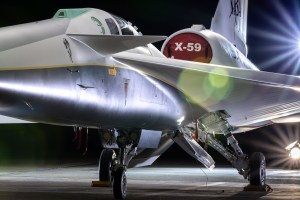
Imagine an event where Orville Wright, along with the first Americans in space and the first humans on the moon, are taking center stage. They are among the decades of aviation pioneers who have received the Robert J. Collier Trophy, including NASA.
The 2008 Collier Trophy honors the Commercial Aviation Safety Team, or CAST, a unique industry and government partnership established in 1997 with the goal of reducing the U.S. commercial aviation fatal accident rate by 80 percent in 10 years. NASA and other members of the CAST team received the award from the National Aeronautic Association before a packed house of aviation notables at a hotel near Washington.
CAST represents thousands of people in public agencies and private industry “who have worked diligently since 1997 to produce the safest commercial aviation system in the world,” according to the Collier Trophy nomination submitted by the Air Transport Association.
The nomination notes the partnership’s original goal “was deemed as quite a stretch” but the year 2008 topped the previous year as the safest year in commercial aviation history. The risk in fatal commercial accidents was down 83 percent from a decade earlier.
CAST is a who’s who of aviation organizations including NASA, the Federal Aviation Administration, the European Aviation Safety Authority, the Transport Canada Civil Aviation, the U.S. Department of Defense, the Air Line Pilots Association, the Allied Pilots Association, the International Federation of Air Line Pilots’ Associations, the National Air Traffic Controllers Association, the Aerospace Industries Association of America Inc., Airbus, the Air Transport Association of America Inc., The Boeing Company, the Flight Safety Foundation, GE Aviation (representing all engine manufacturers), and the Regional Airline Association.
NASA’s Aviation Safety Program has been a part of CAST since the team was established. Executive Committee membership includes the director of the Aviation Safety Program in NASA’s Aeronautics Research Mission Directorate.
“I’m very pleased that the Commercial Aviation Safety Team has been selected for this year’s Collier Trophy,” said the current Aviation Safety Program director, Amy Pritchett. “NASA’s Aviation Safety Program has been instrumental in CAST over its lifetime.”
Researchers at four NASA field installations including Langley Research Center in Hampton, Va.; Ames Research Center at Moffett Field, Calif.; Dryden Flight Research Center in Edwards, Calif.; and Glenn Research Center in Cleveland, have worked with CAST.
They and other members of CAST analyzed data from some 500 accidents and thousands of safety incidents around the world. The idea was to use that information to come up with the most critical safety technologies, systems and procedures to reduce accident risk and ultimately save lives.
“NASA used some of its research and development dollars to develop tools and data mining capability,” said George Finelli, the head of NASA’s Aviation Safety Program from 2002 to 2006 and now the director of the Center Operations Directorate at NASA’s Langley Research Center in Hampton, Va. “Those tools are now part of the Federal Aviation Administration’s safety monitoring system. We tried to align our project activities as much as possible with the major CAST goals and areas of investigation, like runway incursion and aircraft icing.”
“I think it’s incredible that the National Aeronautic Association has recognized the CAST’s efforts,” added Finelli. “One of the things that made the team unique is that member organizations, including airlines, pilots and manufacturers, were volunteering to change what they did, instead of having to follow a mandate.”
Mike Lewis, NASA’s first Aviation Safety Program manager, involved the agency in CAST. “Our program was also data-driven and we wanted to make sure our research and technology development priorities were in line with those of other government agencies and industry,” Lewis said.
This is the second year in a row that NASA shared the Collier Trophy. The National Aeronautics Association awarded the 2007 trophy to a team that included NASA’s Langley and Ames research centers for their work on Automatic Dependent Surveillance-Broadcast, or ADS-B, a system that allows aircraft to be tracked by satellite rather than radar.
Visit the CAST Web site




































